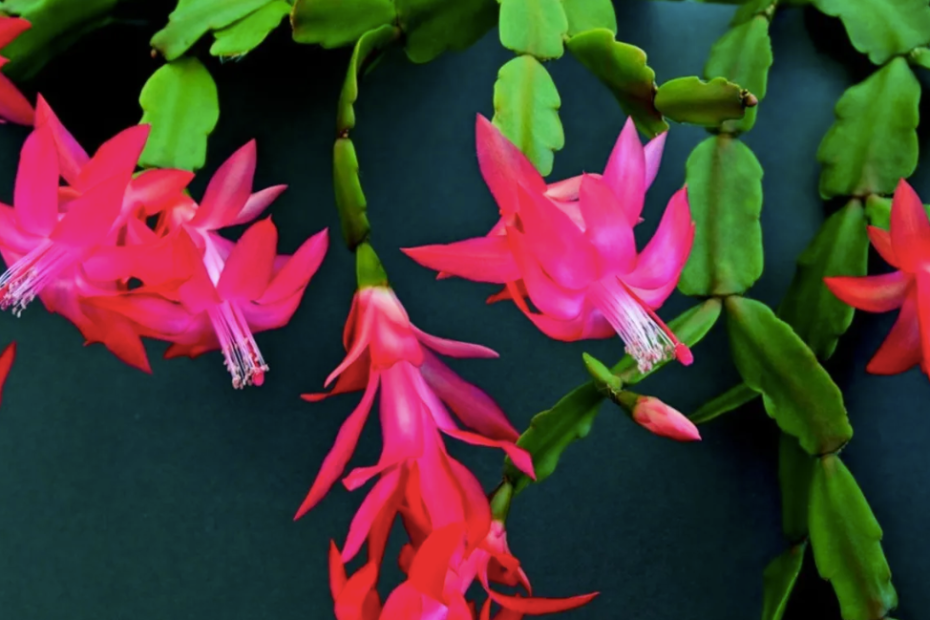How To Make A Christmas Cactus Bloom, According To An Expert: The Christmas cactus (Schlumbergera bridgesii) is a popular holiday gift and low-maintenance houseplant with gorgeous blossoms. Christmas cactus bloom naturally during the wet season, but indoor plants may be induced to bloom by modifying their environment.
Adjusting temperatures and restricting light can help Christmas cactus blossom. After learning how to make a Christmas cactus bloom, you may get it to bloom at different periods.
The Christmas cactus, from the Brazilian Amazon, is interesting. Christmas cactus is real. It grows naturally as an epiphyte in tree crooks. Like other cacti, Christmas has no leaves. Its flattened jointed stalks resemble leaves. These stem tips produce flower buds.
Since we don’t have a wet season, we must use alternative means to blossom. Christmas cactus are light- and temperature-sensitive. Change these parameters to get plants blooming for the holidays.
How To Make A Christmas Cactus Bloom, According To An Expert
1. Fix the Light
- “Day length is the big driver for flowering,” says Oklahoma State University horticulture expert Bruce Dunn.
- Cool temperatures (<70°F), water stress, and indirect light promote flowering, although short day conditions are necessary for blooming.
- Bright daylight and thirteen hours of darkness are optimum for floral bud production. This final point matters. Plants may not blossom if darkness is interrupted, even briefly.
- “The industry uses light control with blackout technology to control flowering,” explains Dr. Dunn. Home light control is simpler.
- At night, cover plants with a black cloth or box for darkness. An vacant room, basement, closet, or heated garage with regulated lighting is another option for plants. Flower buds form after six weeks of gloomy nights.
- After flower buds appear, plants can be displayed indoors. “Keep plants out of direct sunlight, as it can scald leaves,” adds Dr. Dunn. Display ideals include “4-8 hours of indirect light.”
2. Lower Heat
- Christmas cactus thrive in chilly weather. Maintain 60–68°F air temperatures throughout bud formation and try to replicate them in the display.
- Christmas cactus are sensitive to temperature fluctuations and may shed buds if disturbed. Dr. Dunn advises keeping houseplants, particularly Christmas cactus, away from drafts.
- To reduce bud drop, move plants to display as soon as buds form.
3. Keep it fed throughout growth
- Feeding plants consistently during the growing season promotes healthier development and greater fall blooming. Limit fertilizer during bud formation and flowering.
- Once active growth restarts in spring, fertilize with half-strength (10-10-10) fertilizer. Fertilize plants weekly until August.
- The plant should focus on blooming instead of vegetative development in fall. Thus, nitrogen restriction is crucial.
- Some producers use a nitrogen-free, bloom-enhancing fertilizer like 0-15-10 in the fall to enhance bud development, but you may skip it.
4. Avoid Overwatering
- Christmas cactus thrive in rainforest soil but don’t need it too wet. Christmas cactus are subject to root rot, so avoid overwatering.
- Water plants when the top inch of soil feels dry throughout the growth season. Use less water in early October to urge plants to blossom.
- Remember that Christmas cactus bloom during wet seasons in their native habitat. Reduced watering might cause minor water stress and bud development.
- Developing buds and blossoms make plants more sensitive to water variations. They need even hydration to grow blossoms, but too much water might cause buds to drop.
- After buds form, water the same quantity each week but divide it into two waterings to maximize soil moisture.
5. Timing Matters
- After eight weeks of light avoidance, plants blossom. Count back eight weeks from the intended flowering time to ensure plants blossom on time.
- For Christmas blooms, start preparing plants in late September. Give buds six weeks of darkness for best growth. Flowering can continue 5–8 weeks under ideal circumstances.
- Usually in bloom over the holidays, Christmas cactus may be made to bloom year-round. Dr. Dunn claims blossoming can occur throughout summer long days if blackout (total light exclusion) is practiced from 5pm to 8am.
- You can even make plants blossom many times a year. To repeat blooming, “move [plants] back to short day conditions.”
6. Pinch and prune
- Finally, a summer trimming can boost winter blossoms. Pinch stem tips in early June to prune plants.
- Pruning causes more branching and flower-bud-forming shoot tips. Potting cuttings into tiny containers propagates new plants.
- Christmas cactus need more planning than other flowering houseplants, but the stunning spectacle is worth it. After finding your home’s perfect growing circumstances, the method is easy.
- Dunn argues, “the most important [factor] is day length.” “Specifically short-day (long-night) conditions.” Get it properly and you’ll get lots of blossoms.
